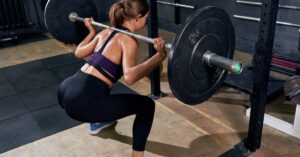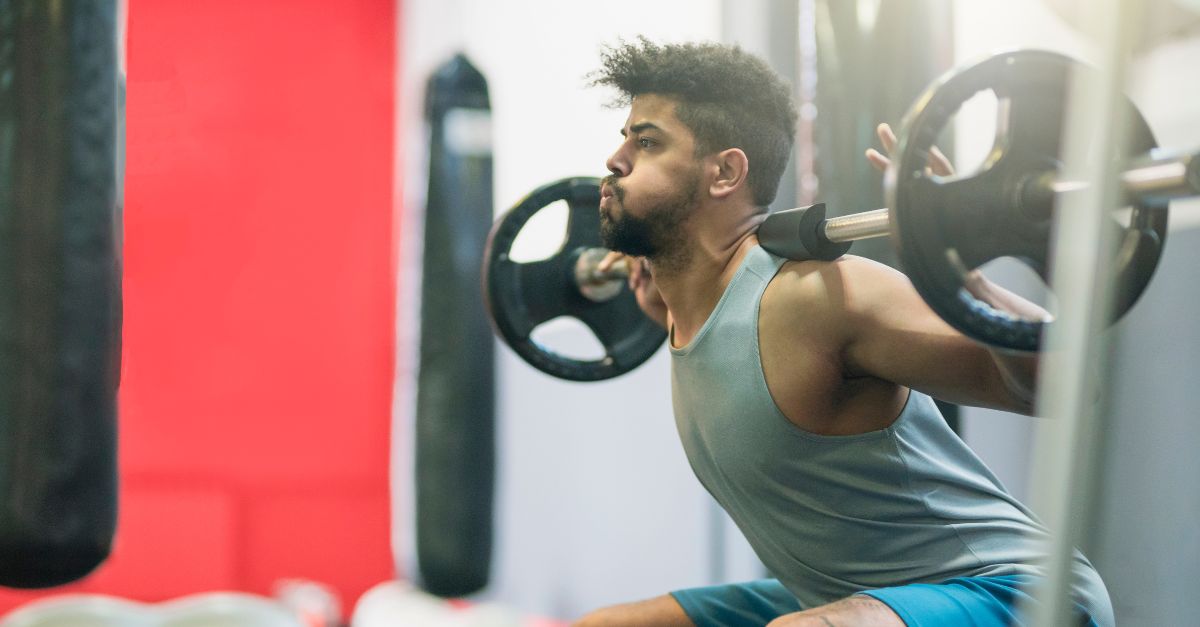Hey there, fitness enthusiasts! If you’ve ever hit the gym with the intention of conquering those squats, only to find yourself wincing from back discomfort, you’re not alone.
Squats are a fantastic exercise for building strength, but they can also be a bit of a nemesis if you’re not careful.
In this blog post, we’re going to dive into the common reasons why your back might be giving you trouble during squats and, most importantly, how to fix it.
So, grab a seat (or a squat rack) and let’s get to the bottom of this pesky problem!
Understanding the reason why you Keep tweaking your back when squatting.
Tweaking your back while squatting can be a common issue, and it’s important to address it to prevent injury and improve your squat form.
There are several potential reasons why you might be experiencing this problem:
Poor Form: Incorrect squat form is a common cause of back discomfort or injury. Make sure you are using proper squat technique, including keeping your back straight, chest up, and knees tracking over your toes.
Engage your core muscles to support your spine throughout the movement.
Lack of Mobility: Limited mobility in your hips, ankles, or thoracic spine can affect your squat form. When you lack mobility in these areas, your body may compensate by rounding your back, which can lead to discomfort or injury.
Regular mobility exercises and stretching can help improve your range of motion.
Weak Muscles: Weakness in certain muscle groups, such as the lower back or core, can make it challenging to maintain proper form during squats.
Strengthening these muscles through targeted exercises can provide better support for your spine.
Overloading: Trying to lift too much weight before you’re ready can strain your back. Gradually increase the weight you’re lifting to ensure your muscles and form are ready for heavier loads.
Fatigue: Performing squats when fatigued can increase the risk of injury. Ensure you’re adequately rested before attempting heavy squat sessions.
Footwear: Wearing inappropriate footwear can affect your balance and stability during squats. Invest in proper lifting shoes or shoe

s with a flat, stable sole to improve your squatting mechanics.
Breathing Technique: Improper breathing can impact your stability and form. Make sure you’re taking a deep breath and bracing your core before descending into the squat. Maintain this bracing throughout the movement.
Progression: It’s essential to follow a structured training program that includes progressive overload and proper warm-up sets.
Rushing into heavy squats without adequate warm-up or progression can lead to injury.
Consult a Professional: If the issue persists, consider consulting with a qualified fitness trainer or physical therapist.
They can assess your specific situation and provide personalized guidance and exercises to address your back discomfort.
Remember, your safety and long-term progress are paramount. Focus on improving your form, addressing any mobility or strength limitations, and gradually progressing in your squat routine.
It’s better to start with lighter weights and proper technique to build a solid foundation and avoid injuries.
Further Explanations.
Let’s dive deeper and elaborate further on all the points mentioned.
Firstly, let’s delve further into these factors that can contribute to back discomfort or injury while squatting:
Poor Form:
Back Alignment: Maintaining a straight back is crucial during squats. When your back is not properly aligned, it can place excessive stress on the spine, leading to discomfort or injury. Imagine a straight line from your head to your tailbone and focus on keeping this alignment throughout the squat.

Chest Position: Keeping your chest up helps prevent your upper back from rounding forward. This keeps your spine in a more neutral position and reduces the risk of back strain.
Knee Tracking: Ensure that your knees track over your toes during the squat. If your knees collapse inward or push too far forward, it can create torque on your lower back, potentially causing pain or injury.
Core Engagement: Engaging your core muscles stabilizes your spine and provides support during the squat. Think of it as bracing your abdomen as if you were about to be punched. This helps maintain a strong and stable back.
Lack of Mobility:
Hip Mobility: Adequate hip mobility is crucial for performing squats safely. When your hips lack mobility, you may struggle to maintain proper depth in your squat, causing your back to round. Hip mobility exercises like hip flexor stretches and hip circles can help.
Ankle Mobility: Limited ankle mobility can lead to compensation patterns, such as leaning forward or lifting your heels off the ground during squats. Mobilizing your ankles with exercises like calf stretches can address this issue.
Thoracic Spine Mobility: The upper back or thoracic spine should remain upright during squats. Poor thoracic mobility can cause rounding of the upper back. Exercises like thoracic spine extensions using foam rollers or mobility drills can improve this.
Weak Muscles:
Lower Back: A strong lower back is essential for stabilizing the spine during squats. Weakness in this area can lead to poor posture and increased risk of injury. Exercises like hyperextensions, Romanian deadlifts, or good mornings can help strengthen the lower back.
Core: The core muscles, including the abdominals and obliques, play a significant role in maintaining spinal stability during squats. Incorporate exercises such as planks, Russian twists, and hanging leg raises to build core strength.
By addressing these factors and incorporating specific exercises and mobility drills into your training routine, you can improve your squat form, reduce the risk of back discomfort or injury, and enhance your overall strength and performance. It’s crucial to work on these aspects gradually and consistently to see improvements over time.
Overloading:
Explanation: Overloading occurs when you attempt to lift a weight that is too heavy for your current strength level or technique. This can lead to improper form, which, in turn, increases the risk of back strain or injury. It can also lead to compensatory movements that place excessive stress on your back.
Solution:
To avoid overloading, it’s crucial to follow a progressive training plan. Gradually increase the weight you lift over time. This allows your muscles, joints, and central nervous system to adapt to heavier loads.
Start with a weight that allows you to maintain proper form and technique, and incrementally add weight as you become stronger and more comfortable with the movement.
Fatigue:
Explanation: Performing squats when you’re fatigued, either from previous workouts or insufficient rest, can compromise your form and balance. Fatigue reduces your ability to stabilize the spine and maintain proper mechanics throughout the squat, increasing the risk of injury.
Solution:
Ensure you are adequately rested before squatting, especially if you’re planning a heavy or intense session. This includes getting enough sleep and allowing sufficient recovery time between workouts.
Consider scheduling your squat sessions earlier in your workout routine when you’re fresh and energized. Listen to your body and avoid pushing yourself too hard when you’re feeling excessively tired.
Footwear:
Explanation: Inappropriate footwear can affect your balance and stability during squats. Shoes with inadequate support or cushioning may lead to instability, making it challenging to maintain proper form.
For example, running shoes with thick, soft soles are not ideal for squats as they can lead to an unstable base.
Solution: Invest in proper lifting shoes or shoes with a flat, stable sole. Lifting shoes typically have a solid, non-compressible sole that provides a stable platform for squats and other weightlifting exercises.
This stability helps improve your squatting mechanics and reduces the risk of wobbling or shifting during the lift. Additionally, ensure your shoes fit properly to provide optimal support and stability.
Addressing these factors will contribute to a safer and more effective squatting experience. Remember that squatting is a compound movement that engages multiple muscle groups and places demands on your entire body.
Prioritizing proper technique, gradual progression, adequate rest, and appropriate footwear will help you maximize your squat performance while minimizing the risk of back discomfort or injury.
Let’s explore these final two factors that can influence your squat performance and safety:
Breathing Technique:
Explanation: Proper breathing is crucial for maintaining stability and strength during squats. When you take a deep breath and brace your core before descending into the squat, it creates intra-abdominal pressure.
This pressure acts as a natural weight belt, supporting your spine and reducing the risk of injury. Failing to brace properly can result in a loss of stability and increased strain on your back.
Solution: Practice a consistent breathing pattern during your squats. Here’s a simple sequence:
Inhale deeply before you start your descent, filling your abdomen with air.
Hold your breath and brace your core as if you’re about to be punched. This creates the necessary intra-abdominal pressure.
Descend into the squat while maintaining this bracing.
Exhale at the top of the movement or after you’ve completed the repetition.
Maintaining this bracing and breathing pattern throughout the squat will help protect your back and improve your overall stability.
Progression:
Explanation: Progression is essential for both building strength and ensuring safety in your squat routine.
Rushing into heavy squats without a structured plan, adequate warm-up, or preparation can increase the risk of injury. Without proper progression, your muscles, tendons, and joints may not be prepared for the demands of heavier weights.
Solution: Follow a structured training program that includes a progressive overload strategy. This means gradually increasing the weight you lift over time. Start with warm-up sets using lighter weights to prepare your body for the heavier work ahead. A typical progression might involve sets of 5 reps with incremental increases in weight as you go along.
Pay attention to your body’s signals and avoid ego lifting, which is attempting weights that are too heavy for your current strength level. Progression should be gradual and sustainable to minimize the risk of overloading your back.
Consult a Professional:
Explanation: If you’ve tried addressing the above factors and are still experiencing back discomfort or pain while squatting, it’s advisable to seek the guidance of a qualified fitness trainer or physical therapist. They can provide a thorough assessment of your squat technique, mobility, and individual biomechanics.
Solution:
A professional can offer personalized advice, prescribe specific exercises to address your weaknesses, and help you modify your squat form to reduce the risk of injury. They can also identify any underlying issues or imbalances that may be contributing to your discomfort and design a tailored plan to address them.
Incorporating proper breathing, following a structured progression plan, and seeking professional guidance when needed are crucial steps in ensuring a safe and effective squatting experience.
Remember that safety should always be a priority in your strength training routine, and addressing these factors will help you achieve better results while minimizing the risk of back issues.
A tabular on this topic here.
Here’s a tabular representation of the various factors that can contribute to tweaking your back when squatting, along with explanations for each factor:
| Factor | Explanation |
|---|---|
| Poor Form | Incorrect squat form, such as rounding the back or improper knee tracking, can strain the back. |
| Lack of Mobility | Limited mobility in the hips, ankles, or thoracic spine can lead to compensatory movements and strain. |
| Weak Muscles | Weakness in the lower back or core can reduce stability and support during squats. |
| Overloading | Lifting too much weight without adequate strength or technique can strain the back. |
| Fatigue | Squatting when fatigued can compromise form and increase the risk of injury. |
| Footwear | Inappropriate footwear can affect balance and stability during squats, impacting form. |
| Breathing Technique | Improper breathing and core bracing can lead to instability and back strain during squats. |
| Progression | Failing to follow a structured training program with gradual progression can increase injury risk. |
| Consult a Professional | If issues persist, consulting a fitness trainer or physical therapist can provide personalized guidance. |
Addressing these factors can help you identify and rectify the underlying causes of back discomfort or injury during squats, ultimately leading to safer and more effective squatting experiences.
Conclusion.
In conclusion, experiencing back discomfort or injury during squats can be attributed to a range of factors, including poor form, mobility limitations, muscle weaknesses, overloading, fatigue, inappropriate footwear, breathing technique, and a lack of proper progression.
To mitigate these issues, it’s crucial to prioritize proper technique, gradual progression, adequate rest, and seek professional guidance when necessary.
By addressing these factors, you can enhance your squat performance and minimize the risk of back-related problems.

Hey there, it’s Mike Rrsq, the Editor-in-Chief over at Jsquat.com, and I’m absolutely obsessed with all things squat fitness! I’ve been lucky enough to get some serious recognition for my work in this field. With a solid background in the fitness and wellness industry, I’ve been there right from the get-go, helping shape this website into what it is today.
You see, I’m not just the boss around here; I’m also a passionate contributor. I love sharing my insights through my articles, and trust me, they’re not your run-of-the-mill stuff. Each piece I write is a labor of love, filled with my expertise and real-world experience in the fitness universe. So, if you’re into fitness and looking for some inspiration, you’re in the right place!

